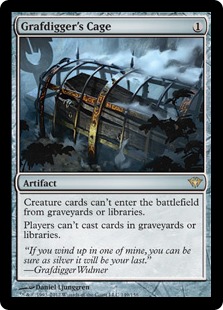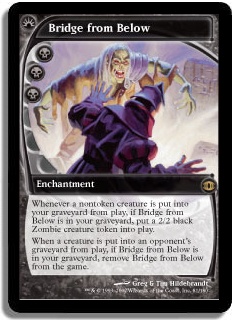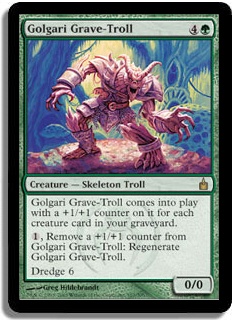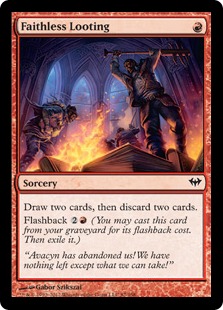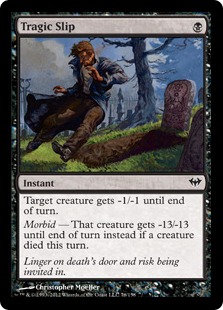Last week, we covered potential applications for Thalia, Guardian of Thraben and touched on what Grafdigger’s Cage wants in a deck. This article is going to be more of the same. It is far more useful to understand a card’s power in a specific context than it is to make broad assertions about a card’s power on a decontextualized scale. As a result, this article is going to have a lot more deck discussion than, say, a financial review.
I ended last week’s article on a quick discussion of how U/W Enlightened Tutor Counterbalance is a strong starting point for building decks that want to play Grafdigger’s Cage.
But wait—isn’t the beauty of the Cage its versatility? Isn’t this the Leyline of the Void for all decks? Isn’t this—as Richard Feldman tweeted—a four-of card for all Legacy sideboards?
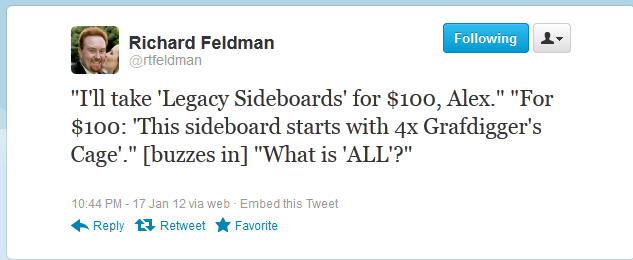
Well, not quite. Of course Dredge decks don’t want to play this, right? It’s a symmetrical effect, so they’d be out cold to their own sideboard card. Reanimator is in the same boat. Maverick has been moving toward a game plan that involves a lot of Green Sun’s Zeniths as well as tutoring up a Scavenging Ooze when X = 2. Did you know that Maverick has cut back to just one Tarmogoyf because Scavenging Ooze is such a powerful creature? That doesn’t sound like a deck that needs a do-nothing artifact to me. RUG Delver is also a value-obsessed deck that wants instants and sorceries whenever it can, so Grafdigger’s Cage doesn’t make that much sense. Granted, it has been cutting back on Snapcaster Mages in recent weeks, but Surgical Extraction will still flip their Delver of Secrets while Grafdigger’s Cage will just wait for a bounce spell.
That’s a lot of decks that look to have better options. So where does that leave us in our quest to find a home for Grafdigger’s Cage? I can think of several decks that really want a Cage:
Mono-Red Burn doesn’t really have many great options for graveyard hate. It has the most generic ones—Relic of Progenitus, Tormod’s Crypt, and the like. Austin Yost played Faerie Macabre and smashed through a Reanimator deck on his way to a trophy, so it’s entirely possible that the deck is just fine with Macabres and doesn’t need Cages. Given that Dredge won’t really have the time to find a bounce spell and be able to do something with the turn they get, though, Cage is about as good as Leyline against Dredge coming from an aggressive deck. This is mostly because Dredge has a tougher time dealing with hate coming from decks that can naturally interact with their Bridge from Belows (Lightning Bolt my own guy and such), since it has to lean that much more heavily on its Narcomoebas and Ichorids to win the game in the absence of free 2/2 Zombies.
Pox-based decks seem like they would love this card. Sure, Leyline is black so you can cast it on turn four if you miss in your opener, but none of your Pox effects make you sacrifice artifacts. Without a turn-one Leyline, you can’t really cast any of your discard effects—symmetrical or targeted—safely. If you have a turn-one Grafdigger’s Cage, though, you can just empty their hand, Wasteland them out, and Raven’s Crime + Wasteland lock them. This plan is something the deck would want to do in a number of other matchups but would not be able to do against Dredge because Dredge doesn’t need (or want) a hand and rarely casts its spells for mana.
Cards like Extirpate do something; they just don’t do everything (like the Cage does). Also, holding up a land every single turn is the most obvious thing ever to any Dredge player who has tested a sideboard game in their lifetime. They will Cabal Therapy you for Extirpate. Don’t play a card that telegraphs itself that hard in a deck that can be totally mana-efficient. If you’re not being mana-efficient on turns where you could gain advantage from using all of your resources, it will become clear to an opponent that you have an instant that you feel the need to cast.
Aggressive non-green decks without relevant graveyard interactions probably want Grafdigger’s Cage. I say non-green because Scavenging Ooze is very likely a better card than Grafdigger’s Cage in decks that want to attack. After all, the time and clock lost by spending some part of a turn casting Grafdigger’s Cage is very real. If you cast a turn-one Grafdigger’s Cage instead of a turn-one Noble Hierarch, you’re deeply wounding an opponent’s game plan, but you’re also setting yourself back about a turn and a half by not casting a turn-one mana accelerant. If you had Ooze + Hierarch or Zenith + Hierarch, you still advance your game plan with Hierarch.
That said, today’s Dredge decks should be sideboarding Firestorm against creature-based strategies to punish people who think that Green Sun’s Zenith for Scavenging Ooze is a panacea. Still, I’d want to play to a Scavenging Ooze game where I have five or more copies of Ooze far more than I’d want to play to a Grafdigger’s Cage game where I have at most four copies of Cage and am shutting off my deck’s best card (Green Sun’s Zenith) in the process.
As mentioned last week, permanent-based blue control decks will get great value out of Grafdigger’s Cage. The problem with that proposition is that none of these decks currently exist. Yes, Counterbalance and Sensei’s Divining Top are still good, but everyone wants to Snapcaster Mage their Brainstorm nowadays. We’ll never get to play Grafdigger’s Cage like that!
The state of blue decks right now is tempo-based. Delver of Secrets, Daze, Ponder, and Spell Snare are all as good as they’ve ever been. The tempo cards in blue have gotten to be at least as good as green and red’s best available cards. There’s no compelling reason to play a lot of easily-disrupted permanents when you could be the one disrupting everyone else with cheap spells and flying Nacatls. Until a control deck comes into Legacy that has the tools to consistently beat a blue Nacatl and also beat a constant slew of mana-advantageous one-for-ones, there isn’t a great reason to play Cage in Legacy blue decks.
I would sideboard Grafdigger’s Cage in any of the following lists:
Creatures (26)
- 4 Mother of Runes
- 3 Jotun Grunt
- 3 Mangara of Corondor
- 4 Serra Avenger
- 4 Stoneforge Mystic
- 4 Mirran Crusader
- 4 Thalia, Guardian of Thraben
Lands (23)
Spells (11)

Creatures (13)
Lands (19)
Spells (28)
Sideboard

Creatures (2)
Planeswalkers (4)
Lands (28)
Spells (26)
- 4 Hymn to Tourach
- 3 Cursed Scroll
- 4 Entomb
- 2 Innocent Blood
- 1 Darkblast
- 3 Life from the Loam
- 4 Smallpox
- 4 Thoughtseize
- 1 Raven's Crime
Sideboard

Creatures (7)
Lands (20)
Spells (33)
- 4 Brainstorm
- 4 Show and Tell
- 4 Force of Will
- 3 Intuition
- 3 Daze
- 2 Misdirection
- 4 Sneak Attack
- 3 Lotus Petal
- 4 Ponder
- 2 Spell Pierce
Sideboard

That said, Legacy is cyclical. When (not if) U/W Enlightened Tutor makes its triumphant return, know that Grafdigger’s Cage is there, waiting for you to come home. Dredge has been a longtime predator of U/W Counterbalance decks, so having the Cage will be a game-changer.
The other deck in Legacy that has the potential to undergo a drastic transformation, unbelievable as it may be, is Dredge.
Yes, Dredge, the deck that everyone is saying will get railed by Grafdigger’s Cage. I’m not buying it. Dredge has seen so many hate cards in so many different formats that it’s a little silly to think that another one-mana artifact is the end of the line for the Villain That Could. Dark Ascension brings three different tools to the table for Dredge, and none of them should be overlooked. Let’s get ourselves a starting point, first:
Creatures (25)
- 4 Putrid Imp
- 3 Ichorid
- 1 Flame-Kin Zealot
- 4 Golgari Grave-Troll
- 3 Golgari Thug
- 4 Stinkweed Imp
- 1 Angel of Despair
- 4 Narcomoeba
- 1 Sphinx of Lost Truths
Lands (15)
Spells (20)

There are a lot of things that I love about this list. It plays fifteen land, for starters. Do you know how many Dredge decks I’ve watched lose to their own mulligans because they just can’t find a single land? It’s depressing. I know the deck has a reputation for unfairness, but really, you have to have a land to play ball with this deck.
I also love that it plays Undiscovered Paradise over Tarnished Citadel. I’m not a fan of Lightning Bolting myself when there are decks that want to spend a card to do so. Paradise doesn’t synergize perfectly with Cephalid Coliseum, but it doesn’t kill you every time you want to cast a Careful Study or pay for a Daze.
I’m not a huge fan of Angel of Despair. It seems like a nitpick, but it’s part of a larger issue, which is that you have to know what you want to do with your deck. Dredge can be built to be a combo deck, but this one isn’t. It has Firestorm main, making it a much more controlling deck already. It doesn’t play the full four Careful Studies. Finally, it’s missing a card that every Dredge deck from now on should be playing:
The days of Lion’s Eye Diamond Dredge are back. Grinding people out through Snapcaster Mage for Surgical Extraction or Green Sun’s Zenith for Scavenging Ooze are over. It’s time to figure out how to get people dead with Dredge again. Let’s look at the big reason why we want Lion’s Eye Diamond:
Faithless Looting is everything that a combo Dredge deck has ever wanted. It’s a Careful Study, which is valuable already—in a midgame situation, that means up to 12 new cards off the top. But it also doubles up on its role, playing the part previously held by Deep Analysis.
Deep Analysis, for reference, was included in a lot of early Lion’s Eye Diamond Dredge (LEDD, from now on) lists as a way to ensure that the deck could keep “going off.” The sequence usually went as follows:
Land.
Breakthrough with X=0, hold priority.
Activate Lion’s Eye Diamond for UUU, discarding a dredger.
Replace all four draws with dredges, keeping in mind that you can choose a card you flipped with one dredge to replace the next draw. This works because “draw four cards” in Legacy translates to “Draw a card. Draw a card. Draw a card. Draw a card,” letting you treat each draw as a separate event that you can replace (or not replace) separately.
Discard the four cards you dredged.
Put your Narcomoebas into play.
Realize you have no way of getting three creatures into play just yet.
Flashback Deep Analysis for 1U and three life.
Dredge another 12 cards.
Flashback Cabal Therapy and/or Dread Return, win the game shortly thereafter.
Now that we have Faithless Looting, we get to play more Careful Studies than Casey, more Lion’s Eye Diamonds, and more ways to win on turn one. Pretty sweet, right? Here’s how I would build Dredge for Sunday:
Creatures (21)
- 4 Putrid Imp
- 1 Ichorid
- 1 Flame-Kin Zealot
- 4 Golgari Grave-Troll
- 3 Golgari Thug
- 4 Stinkweed Imp
- 4 Narcomoeba
Lands (14)
Spells (25)

This is not a perfect list. It eschews a lot of what older Dredge lists tried to do for a more streamlined combo kill. A lot of the numbers require explanation, so let’s get into that:
Eleven dredgers: On the short side, to be frank. Richard Feldman probably hates this list already, just from the three next to the Golgari Thug entry. He may very well be right. In all honesty, twelve dredgers is a lot better than eleven.
Fourteen lands: Possibly a bit high given the presence of LEDs, but I’ll justify this a bit more when we get to the sideboard cards. David Thomas has pretty consistently played twelve lands in his Lion’s Eye Diamond lists, so playing fourteen is a little strange. Without knowing the sideboard, you’re right to question all of these mana sources.
Three Cabal Therapy: This is likely to be the most controversial decision. Cabal Therapy is the deck’s primary form of interaction, so why cut down on it? To be perfectly frank, it’s because the deck has never wanted to interact less than it does now. Blue decks are playing cards like Spell Snare and Daze that barely interact with us, so we only really care about Therapying for Force of Will to get our Dread Return off. We aren’t interested in grinding people out with Ichorids and Zombie tokens. We just want to kill people quickly and move on.
One Ichorid: Same as above—we aren’t planning on returning these that much, so having a bunch of duds in our turn-one or turn-two big dredges seems poor. Ichorid also doesn’t feature prominently in our sideboard plans.
Only one Dread Return target: Flame-Kin Zealot is a must-have in LEDD lists. Passing the turn is a pretty bad thing to have to do, since it opens the door for an opponent to cut you off of the three creatures necessary to flashback Dread Return. We’d like to avoid that whenever possible. Faithless Looting is our Cephalid Sage or Sphinx of Lost Truths, so to speak, and so we don’t need cards like those.
Again, it’s possible that Dredge masters can tune this list better than I can, but this is where I would start. So where does the sideboard come into play? Well, you could play a conventional sideboard that looks something like this:
4 Chain of Vapor
4 Firestorm
2 Ichorid
1 Memory’s Journey
4 Nature’s Claim
This sideboard plan gives you eight outs to Leyline and Cage, eight outs to Scavenging Ooze, an out to Surgical Extraction, and a way to grind out blue decks. It’s safe, it’s reasonable, and it’s not something Richard Feldman or Max McCall would ever have you play. In fairness, though, they wouldn’t have you play my idea, either. What would I play?
4 Tarmogoyf
4 Tombstalker
4 Ghoultree
2 Darkblast
1 Life from the Loam
This is a sideboard that I can get behind. An opponent keeps a hand because it has Snapcaster Mage and Surgical Extraction for your Narcomoebas and Ichorids, but your first dredge shows them none of those! Instead, your sideboard plan went like this:
-2 Dread Return
-1 Ichorid
-1 Flame-Kin Zealot
-4 Lion’s Eye Diamond
-4 Breakthrough
-3 Cabal Therapy
+15 cards that beat them up
The final list, then, is:
Creatures (21)
- 4 Putrid Imp
- 1 Ichorid
- 1 Flame-Kin Zealot
- 4 Golgari Grave-Troll
- 3 Golgari Thug
- 4 Stinkweed Imp
- 4 Narcomoeba
Lands (14)
Spells (25)
- 4 Careful Study
- 3 Cabal Therapy
- 4 Breakthrough
- 4 Lion's Eye Diamond
- 2 Dread Return
- 4 Bridge from Below
- 4 Faithless Looting
Sideboard

This sort of transformation was never possible without Ghoultree. Tarmogoyf and Tombstalker were reasonable creatures to transform into, but they both cost two mana. What this deck really wanted in a sideboard transform was a 10/10 for one mana, and hey! Would you look at that? Wizards gave us Ghoultree.
The beauty behind this is that people should be playing Grafdigger’s Cage over Leyline of the Void nowadays. It’s better in almost every way. This transformation just takes advantage of the fact that Cage is unlike Leyline in one very important way: it lets you keep dredging. Sure, you don’t get to freeroll your Narcomoebas, and sure, you can’t return Ichorid. But does that matter if you cast a turn-two Tarmogoyf and a turn-three Ghoultree? Can they deal with Tombstalker at all?
It’s worth noting that the two Darkblasts and the Life from the Loam are strong against Cage decks as well. Loam lets you rebuy lands so that you can reuse Cephalid Coliseum, rebuy Gemstone Mine, and even cast your Grave-Trolls! Meanwhile, Darkblast solves the awkward problem of a Tarmogoyf vs. Tarmogoyf staredown or an annoying Mother of Runes that threatens to brickwall your Ghoultrees and Tarmogoyfs until they find a removal spell.
There’s no question about the fact that this sideboard plan is ambitious and risky. It may even want a fifteen land to operate properly. The fact of the matter, though, is that Dredge has been the deck in Magic’s history that has wanted a transformational sideboard the most. Given how many graveyard hate cards exist that don’t actually stop Dredge from dredging, though, it might just be time for Dredge pilots to pull a fast one on the competition.
As for that promised third card? Well, Vintage expert and former SCG columnist Stephen Menendian has been singing the praises of Gravecrawler in Vintage Dredge, but I’m not seeing Dredge sideboarding Jungle Lion in Legacy. No, the third card was going to be Tragic Slip.
As I thought about and discussed Tragic Slip with more people, though, it became clear that Darkblast was just undeniably better. Even though Darkblast is from Ravnica, I feel like it’s due for a renaissance in decks of all strategies and colors. Tragic Slip is great in a removal-heavy black deck that’s conscious of its curve (or perhaps wants its removal to dodge Spell Snare), but Darkblast does so much for black decks nowadays.
Let’s think about it:
- Kills Delver on the play or the draw with mana parity. If on the play, you can cast it in your upkeep, get it Dazed, dredge it back, and cast it again. If on the draw, they have to have Daze + a natural flip on turn two to dodge Darkblast. If they don’t flip it, you get to rebuy and go again for no cost.
- Kills every Delver after turn one on sight.
- Kills every Mother of Runes on sight.
- Kills all the X/1 creatures running around Legacy at a mana advantage (the list is really long).
- Lets you feel good about using your removal spell to kill their Dryad Arbor or Noble Hierarch, whereas you will generally want to hold your Lightning Bolt for a better card like Scavenging Ooze.
- Feeds Snapcaster Mage.
- Feeds Nimble Mongoose.
- Lets you dredge away bad Brainstorm stacks and the bad two cards from a Ponder.
- Wins Tarmogoyf wars.
- Lets you cheat on removal slots, since you can always just dredge it back and go again.
It’s very possible that, given how good Darkblast is, Tragic Slip can beat out Go for the Throat as the best objective black removal spell. Sure, it won’t wax their Tarmogoyf 100% of the time, but you were going to kill their Noble Hierarch with Darkblast anyway, so you might as well get their Tarmogoyf (or Knight of the Reliquary) for a discount while you’re there. Both Nick Spagnolo and Eric Gosse knew how good Darkblast was in DC:
Creatures (2)
Planeswalkers (6)
Lands (24)
Spells (28)
- 4 Brainstorm
- 3 Counterspell
- 3 Force of Will
- 2 Smother
- 1 Standstill
- 1 Crucible of Worlds
- 3 Pernicious Deed
- 1 Life from the Loam
- 1 Repeal
- 2 Spell Snare
- 1 Damnation
- 1 Maelstrom Pulse
- 3 Spell Pierce
- 2 Inquisition of Kozilek
Sideboard

Creatures (11)
Planeswalkers (2)
Lands (20)
Spells (27)
- 4 Brainstorm
- 4 Hymn to Tourach
- 4 Force of Will
- 1 Sylvan Library
- 4 Daze
- 2 Snuff Out
- 4 Ponder
- 2 Maelstrom Pulse
- 2 Preordain
Sideboard

I would expect the numbers of Darkblasts to only go up as more people grasp the value and utility of this card. It will be interesting to see how widely people adopt a card like Tragic Slip, though, since its power is clearly up to Legacy snuff.
I’ll be in Richmond this weekend, battling in both the Standard and Legacy Opens. If you have some sweet new tech from Dark Ascension, don’t hesitate to come up and introduce yourself! I’m excited to play with the new set and see what everyone has come up with.
Who knows, maybe there will even be a few Ghoultrees in the top eight…
Until next week,
@drew_levin on Twitter

